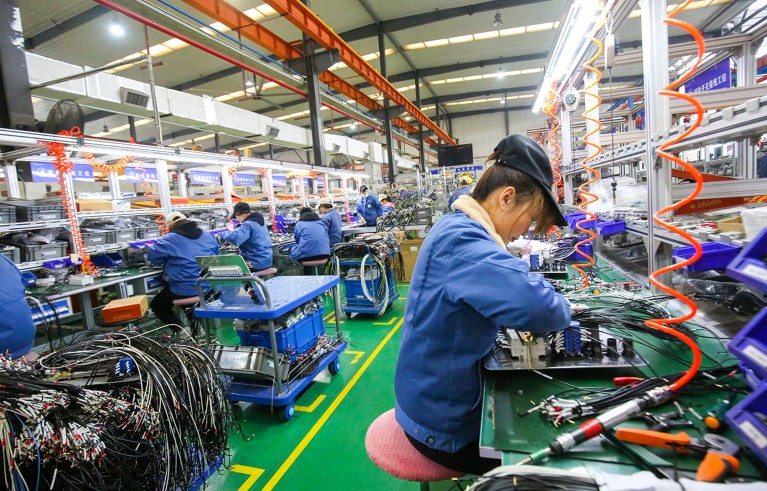
Increasing demand for digital technologies drives work at the world’s largest transformer supplier, in Rugao, China.Credit: Costfoto/Future Publishing/Getty
Growth: A Reckoning Daniel Susskind Allen Lane/Belknap (2024)
For decades, the global economy has been growing by 2–5% per year. This growth is eating up ever more resources, destroying biodiversity and ushering in dangerous levels of global warming. Endless growth of this kind isn’t sustainable. What can be done? Should growth be maintained, but differently, to protect Earth while resolving inequalities and other social problems? Or should growth be curbed and the global economy stabilized or even shrunk? These are crucial questions with complex answers, about which people disagree fervently.
In Growth, economist Daniel Susskind delves into the roots of these problems and offers suggestions. His passages putting economic growth into historical context are engaging. Yet, in my view, his wider analyses and solutions are too limited to make this book a good starting point for the broad moral discussion that he advocates.
Growth, past and future
Table of Contents
Susskind begins by pointing out how economic growth is a recent phenomenon. For around 300,000 years, while societies were mainly agricultural or capable only of subsistence, overall long-term prosperity remained more or less stagnant. Then, around the start of the nineteenth century, something unprecedented happened: the global economy began a 200-year growth spurt.

How rich is too rich?
Why? Economists have no definitive answer, Susskind rightly concludes. He provides an insightful overview of hypotheses, based on factors including capital investment, technological progress, skilled and educated workers, and cultural and institutional conditions. He highlights the importance of innovations such as medical science and breakthroughs in transportation and manufacturing. And he stresses that a society that is more receptive to science is also culturally better equipped to apply these innovations in the economy.
In the aftermath of the Second World War, economic growth was propelled to the top of the list of policy objectives in the West. It was seen as key to rebuilding shattered European economies, and crucial to prevailing in the cold war and in creating full employment — an important objective since the Great Depression in the 1930s. The idea spread and went on to become a global policy objective.
Gross domestic product (GDP) came to be seen as a measure of the success of a society — and an end in itself, rather than a means to an end, as most economists see it. But this posed a “growth dilemma”, Susskind notes. On the one hand, “GDP is correlated with almost every measure of human flourishing”. On the other, the fossil fuels and digital technologies underlying this economic growth are “climate-destroying, inequality-creating, work-threatening, politics-undermining, and community-disrupting”.

Illegal gold mining has led to deforestation in the Peruvian Amazon.Credit: Cris Bouroncle/AFP/Getty
Public discussions about how to resolve this dilemma are contentious, even factional. To oversimplify, there are two main camps. One, championing ‘green growth’, extols the benefits of economic expansion and stresses that it can be achieved sustainably. The second, focused on ‘degrowth’, argues that economic growth is not the solution to social and ecological problems, but the cause. It holds that these issues can be solved only by a democratically agreed reduction in growth in rich countries.
Susskind refers to his own position as “weak degrowth”, but spends much time analysing how to “unleash” growth by reforming intellectual-property laws, increasing research and development and getting more people to innovate. He makes a powerful argument that society must dictate the direction of innovation — towards green technologies, for example — to reduce the negative effects of growth.
Yet, Susskind admits, hard choices will inevitably be required. Choosing whether to pursue more or less economic growth will always affect “other goals”, such as a healthy climate, fair distribution of wealth, cohesive communities, well-paid and high-quality work and a functioning democracy. To navigate these decisions, he suggests, society will need to ask itself some deep “moral questions” through participatory democratic processes such as citizens’ assemblies.
A reckoning
What should a reader make of this? Just like Susskind, I am no expert on all the scientific domains needed to make such choices. No one is. I’m sympathetic to his remark that it is impossible to write on such a broad topic and provide a full and uncontroversial overview of all the literature. But, in many sections, such as the one on GDP, I was unconvinced.
I have worked in national accounts and on alternatives to GDP. Yet I was confused by Susskind’s argument that economists should follow “GDP minimalism”, such that GDP should be limited to measuring the “taxable income” of society. He lists many well-known problems with GDP and proposals to expand its scope, but does not say what exactly he would change.

Why the world cannot afford the rich
For example, Susskind argues that economists should not expand the scope of GDP by factoring in damages such as air pollution. He bases this on “moral modesty” — in his view, value-laden choices have no place in a quantitative metric. Yet he does not provide a comprehensive way of judging what is in and what is out. Many sectors that contribute to current GDP figures — such as tobacco, alcohol, fossil fuels, gambling, social media and businesses that take advantage of monopolies or price gouging — might also be considered immoral. Should those be removed?
Susskind also wants to restrict what GDP measures to emphasize “technical diligence”. It is unclear what that would mean. The quantity and quality of health services are hard to measure, for example; should these be excluded from economic growth figures? And the availability of data varies for each country. Should internationally comparable GDP figures be abandoned and each country have its own definitions? Or should economists revert to the lowest common denominator, considering only factors for which every country has adequate statistics? The book is inconclusive.
Susskind suggests using a dashboard of indicators rather than adjusting GDP. Yet, strangely, he doesn’t reference influential dashboards such as the United Nations Sustainable Development Goals or its predecessors, the Millennium Development Goals, which have existed for decades.
Moral maze
Deeper problems lurk in the theoretical foundation of Growth. Four things stand out.
First, the standard view in the literature is that economic growth is a means to an end, not the end itself. Yet, without justification, Susskind frames his arguments around achieving economic growth as a goal, alongside others.

To build a better world, stop chasing economic growth
Second, he argues that, because ideas are infinite, there is no limit to possible economic growth. This is quite a claim, and he does not provide convincing support. He simply points to the possible combinations of atoms and the number of recipes one could make from a given set of ingredients. Because the number of variations is huge, he thinks it likely that society will continue to generate enough useful ideas to go on expanding the economy.
Yet, some of the books Susskind refers to undermine that. For example, Robert Gordon’s Rise and Fall of American Growth (2016) argues that the generation of useful ideas (those that contribute to quality of life) has slowed since the 1970s, and that this is why we should not expect economic growth to continue.
In medicine, too, the rate of discovery has reduced in the past few decades. Life expectancy dropped in many countries during the COVID-19 pandemic. And many high-income nations are experiencing increased mortality owing to ‘bad’ ideas including drugs, alcohol, fast food and guns.

Degrowth can work — here’s how science can help
Third, Susskind argues that growth-driving ideas are unrestricted by the limits of a finite planet. Yet, scientists have shown that six out of nine ‘planetary boundaries’ — Earth systems, such as climate change, that will have a huge effect on current and future generations — are being crossed (K. Richardson et al. Sci. Adv. 9, eadh2458; 2023). Given this, Susskind’s unfounded optimism seems too large a risk.
Fourth, Susskind’s ‘moral discussion’ framing seems restrictive. He is willing to sacrifice a bit of growth for the sake of “other” societal goals. But, frankly, I was expecting a deeper discussion of what constitutes ‘a good life’ and how those lives could be led in a way that respects the limits of the planet and takes into account other people and future generations. I would also expect a discussion of the sacrifices that people might need to make, in terms of diet, transportation, consumption or taxation. I see no justification that ‘expanding economic activity by between 0 and x%’ is a valid boundary to such a fundamental moral debate.
In sum, Growth offers a readable and useful introduction to the green-growth perspective. There are insightful parts and I support a plea for a moral reckoning. But the book omits crucial environmental insights and lacks the robustness needed for such a foundational debate around the goals of society.
